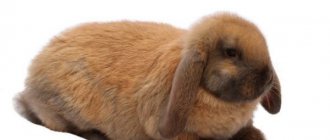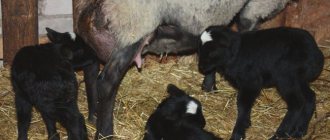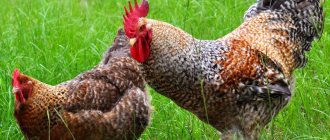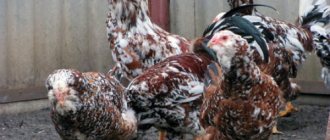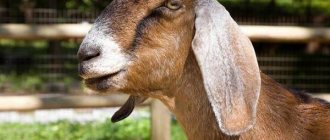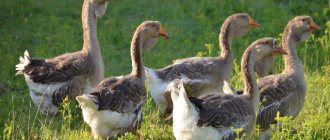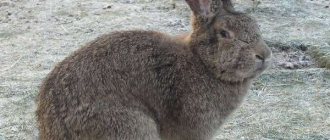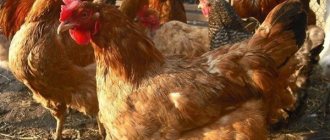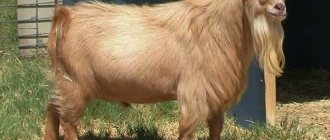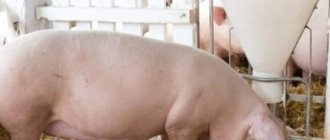Origin
The Large White breed originates in Yorkshire from the mid-nineteenth century. The new variety differed from the short-legged and overly obese brothers familiar to the British in other constitutional indicators - the bred white pigs were large, dense and well-fed, but at the same time their legs were quite long and their bones were strong. Yorkshire pigs immediately gained attention and quickly became popular among large breeders.
Over time, large white pigs spread beyond England, where, through the efforts of local breeders, they modified and adapted to the local climate. In Russia, the breed of white pigs had to be selectively adjusted so that they could better withstand cold and dampness. The white pigs that the vast majority of farmers raise today are different from the original Yorkshire pigs.
Breeds of pigs for backyard breeding: important features
First of all, you need to decide: do you need one or two pigs just for the family or do you have a goal to start a business? Pork is in demand in our country, especially farm pork, which by definition is of the highest quality. Pigs are easy to raise (the average litter per year is 30 piglets), building a pigsty is not the most difficult thing. But you need to know: pigs need constant care, preventive examinations and treatment.
Pigs in a pigsty
There is a common myth that pigs are omnivorous, and can be fed anything without having to spend a lot of money on feed. However, with such a diet, the pig’s meat will be of low quality and even dangerous to health. Selling it at a high price, much less finding regular customers, will become impossible.
Methods of content
In Russia and neighboring states of the former USSR, a no-walk method is widespread, namely the construction of a pigsty. All technical recommendations can be found in specialized publications. In short: it must be warm in the cold season, good ventilation.
Pigsty
The floor should be at a slight slope, with a sufficient amount of bedding (straw, hay, sawdust). It must be changed once a week with simultaneous cleaning to avoid outbreaks of infection. Disinfection should be carried out monthly: using special agents based on chlorine and formaldehyde, clean the walls, pens themselves, floors, etc.
Tips for setting up a pigsty
It is advisable to have a small pool for rinsing pigs in them. In summer it should be cool: otherwise the pig will gain weight poorly, or even lose it.
Stall with pigs
A walking system is preferable. Pigs get sick less, their meat tastes better, and there are no conflicts within the herd. The site must be strong and carefully fenced. It is necessary to plant various legumes on it: clover, sweet clover, etc.
Pasture
The farm or site must have a source of clean water, convenient road connections for bringing in feed and transporting it to slaughter. If the animal becomes nervous due to potholes, noise, etc. its meat after slaughter will taste significantly worse.
Device diagram
Feeding
The productivity and fertility of various breeds of pigs depends on the optimal feed suitable for a particular breed. Every day the feed should contain at least 18% protein. Grains (oats, corn, wheat) should be consumed in moderation, especially in the diet of meat breeds. Be sure to have different types of vegetables. The market offers ready-made dry food with a balanced content of all nutrients.
Daily ration
Characteristics and description
The breed of white pigs belongs to the meat-greasy breed. Adults gain a maximum of about 340 kg. weight in males and 230 kg. in females. It is characterized by increased fertility: it produces 8-12 cubs in one litter. Young animals gain weight very quickly, with the correct selection of diet - up to a kilogram per day. Two-month-old piglets reach a weight of 20 kilograms. The amount of pure meat produced by the breed is up to 80% by weight.
Features of the constitution and structure of the white breed:
- medium-sized head and snout with a large forehead, medium-sized elastic ears, turned forward and to the sides, can stand upright or be turned forward with raised tips;
- the body is uniformly large, the stomach does not droop, the back is arched;
- the legs begin with large hams, medium-length neat hooves;
- light thin skin covered with sparse whitish hair, the skin is smooth, not folded;
- Representatives of white breed pigs have a calm, non-aggressive character.
Peculiarities
Black pigs are also divided into three large groups:
- sebaceous;
- meat products;
- meat.
To date, several breeds of these animals have been bred, with such an unusual color for their group. But they all share a common characteristic:
- the ears are quite large, drooping, while the head itself is small in size;
- the back part of such animals seems to hang down against the background of the rest of the carcass;
- The body of black pigs of any breed is always elongated, and the legs are large and end where the hocks begin;
- the body is large, muscular, all muscle groups are well developed;
- the live weight of an adult mature boar can reach 350 kg, females – 250 kg;
- the chest of these animals is powerful and wide;
- the average body length can reach 175 cm;
- There are skin folds on the legs.
At the same time, it is black pigs that those people who have decided to try their hand at pig farming for the first time in their lives should start breeding. Animals grow quickly, gain weight well, and some breeds are less demanding to care for compared to their pink relatives.
What other types of large white pig are there?
The popular breed of pigs from Yorkshire spread widely around the world and in each of the regions where it appeared, it underwent changes over time, with the help of breeders adapting to new climatic conditions and a change in diet.
Useful video
In this video you can see how the descendants of pigs from Yorkshire, bred in other countries (USA, Germany, Hungary, Ireland) differ in appearance:
Ukrainian steppe
Appeared in 1926-1934, through the efforts of the breeder and member of the Academy of Sciences of the Ukrainian SSR M.F. Ivanova. Created specifically for the hot and arid part of Ukraine, the steppe zone. Comes from the mating of local late maturing females with breeding white Yorkshire boars.
The characteristics are slightly different from the original: the ears of the Ukrainian steppe are larger, drooping, the skin is denser, and the stubble is thicker. The animals eat up and grow a little slower than their white ancestors.
Siberian northern
Appeared in the early 40s at the Novosibirsk Research Institute of Animal Husbandry. From its English ancestors, the Northern Siberian inherited a light color (sometimes reddish), protruding ears, a large arched back, and a calm disposition. Siberian blood results in rougher skin and thicker hair, which allows pigs of this variety to withstand harsher winters. The meat yield of Siberian pigs is lower, and they grow somewhat slower than their English ancestors, but the adaptability of this breed to Siberian weather with its wide seasonal temperature range makes them an ideal option for breeding in Siberian conditions.
Yorkshire
The original "white English pigs". Compared to their Russian counterparts, Yorkshires are larger and more massive. In Russia, a pure breed is rare, since many people cannot afford purebred Yorkshire pigs, and they are much more difficult to maintain than hybrid varieties.
Yorkshire pigs are distinguished by their tucked bellies, large protruding ears on a small head, elongated body and short legs. There are no folds on the skin or legs. The character is calm and flexible. Yorkshire meat makes excellent marbled pork. They do not tolerate cold well, from which they often begin to catch colds, and heat - strong sunlight is dangerous due to the formation of burns on the skin. They have a tendency towards obesity.
Latvian white
Comes from matings of large whites with Latvian ones, with the addition of admixtures of German long-eared ones. Representatives of the variety look very similar to English white pigs: light skin, balanced bones, long body. The height at the withers is slightly greater due to the length of the legs; the ears may droop. The weight and meat yield is slightly less than that of Yorkshires and large whites. The Latvian white pig breed is prolific and early maturing.
Most popular in Latvia and north-west Russia.
Belarusian large white
One of the most recent on the list, developed in the last two decades. More than half of the pig population in Belarusian large pig farms belongs to this variety. Large white Belarusians have a universally built body with balanced bone structure. Their body is elongated, their head is low. This variation of large white pigs has shown itself well both in monobreeding and in hybridization. Females are prolific (12.1 cubs per litter on average), meat yield is 60%.
History of appearance
The homeland of the white pig is Great Britain, where the first representatives of this breed appeared at the end of the 19th century. The need to develop a new breed arose due to the threat of degeneration of pigs of another breed, Yorkshire.
As a result of serious breeding work done by British breeders, they managed to obtain a new, very promising and prolific breed of pigs. It differed favorably from its local relatives with its strong legs and proportional physique and gave excellent live weight gain.
The first purebred pigs were brought to the Russian Federation in the 80s of the twentieth century. Thanks to its ability to adapt to the surrounding climatic conditions, the new breed has reliably proven itself among domestic livestock breeders.
It should be noted that selection work with the breed continued in Russia. And at the moment, domestic representatives of the white breed differ significantly in a number of indicators from their British relatives.
In addition, individuals of the white breed participated in the breeding of other productive breeds.
How to choose piglets when purchasing?
If you decide to purchase large whites, you should first take a closer look at two-month-old pigs. It is important to ensure that the piglets have already eaten at least 20-25 kilograms of live weight. Healthy cubs are active and have a good appetite. When trying to pet or catch a piglet, a healthy animal will run away and dodge squealing. Apathetic behavior indicates illness or developmental delay.
Before purchasing you should find out:
- approximate pedigree of piglets;
- how the piglets were fed (diet composition and feeding frequency);
- what supplements were included in the diet (vitamins and nutrition);
- whether vaccination against dangerous diseases was carried out, when is the next time;
- Are the animals neutered?
A sudden change in diet when moving can cause stress and weight loss in pigs, and a lack of immunity from swine infections can provoke an outbreak of disease on your farm.
Feedback from livestock farmers
Matvey, 37 years old, Saratov
In my experience, the most unpretentious to feed, resistant to disease, early maturing, prolific and dairy breeds are our proven breeds - Large White and Soviet Meat (SM-1). Of course, buying purebred piglets is not easy or cheap. We took several KB from a private farm - clean, well-fed, active, with a good appetite. Each piglet (two months old) weighed more than 25 kilos. If you buy on the market, then you should not expect any guarantees of compliance with breed standards and vaccinations.
Ekaterina, 44 years old, Kuzbass
If I feed them a complete diet, I like white pigs (promki) the best. In 6 months they reached 100-110 kg live. And the Vietnamese (we have mini pigs) – 40-50 kg. At the same time, the whites ate about 400 kg each, and the Vietnamese 200 kg each. The choice depends on the purpose of raising pigs: for yourself, for sale or as a hobby.
Nikolay, 52 years old, Vinnytsia region
Now real lard is in great short supply, and there is a dominance of meat breeds all around. But I believe that any animal has meat, but only pigs have lard, which is why I like white ones. We specially feed grain and potatoes so that the lard becomes thick (in some places as big as 4 fingers), soft, tasty, whether for yourself or for sale - it goes in great demand.
Care and feeding
For large white pigs, the correct temperature regime is very important; they can hardly tolerate changes in temperature, cold and heat. The room for pigs is made insulated and sufficiently lit, with mandatory ventilation, but without drafts.
The flooring in the pigsty is preferably wooden, and hay or straw is used as bedding material. This protects pigs from hypothermia.
Due to the breed's tendency to obesity, pigs require a separate place for walking in addition to the main pigsty. Separate pens are usually made for keeping growing piglets.
The mother and piglets will also need a separate room of about 6 square meters. m. It must also be clean, insulated, with sufficient lighting and ventilation.
Large white pigs have difficulties with nutrition; not any food is suitable for them. To avoid obesity, it is necessary to diversify your diet (grain mono-diets will cause increased fat deposition).
Note! An adult large white pig should receive about 5-6 kg per day. feed, 10 g. salt and about 10 l. water. Piglets are entitled to two to three kilograms of feed per day.
A typical diet for a white breed consists of boiled potatoes, carrots and beets, grains, grass meal, tops, hay, fresh greens and seasonal green food, dairy products, vitamin supplements, minerals and fish meal.
Piglets and boars can eat almost without restrictions, but sows need to be monitored so that they do not overeat, as this can adversely affect the process of gestation and childbirth.
Content
When planning to breed white pigs, it is necessary to take into account some features of its maintenance at the planning stage.
Individuals need a warm room with good ventilation. The large white pig is unpretentious, but reacts poorly to low air temperatures and high humidity in the room. Therefore, even before purchasing pigs, you should insulate the pigsty and provide it with a good air ventilation system. In addition, thoughtful and good lighting of the room where the animals will live is required.
The arrangement of a pigsty requires the presence of an area for walking animals with a small pool for mud baths. It is recommended to provide a canopy on the walking area to protect the skin of the pigs from hot sun rays to avoid burns. This issue is especially relevant for the southern regions of the Russian Federation.
The internal arrangement of the pigsty involves insulation of the floor, walls and ceiling. It is necessary to make grooves or a slope on the floor to drain waste. It is recommended to make the floor covering from wood. This floor is warmer than concrete. It is important to take care of the bedding. The best option is soft straw, which should be changed regularly.
Requirements for the pen:
- The area of pens for young animals is calculated at 3 square meters per individual.
- Adult pigs will require 4 square meters per head.
- A sow with piglets needs at least 6 square meters of separate area.
Beginning livestock breeders should take into account that white pigs like to gnaw partitions and make tunnels. For this reason, it is necessary to put together reliable partitions from hardwood and install a durable floor in the pigsty.
This recommendation should also be taken into account when organizing an area for walking pets. It is necessary to install a strong fence and ensure that the pigs do not escape through the tunnel they have dug.
Organizing optimal living conditions will help maintain the health of animals and protect them from various diseases. A well-equipped room with a comfortable temperature, high-quality lighting and ventilation system is the key to future profits from breeding pigs of this breed.
Reproduction
Puberty in females of the large white breed occurs in the sixth month of life, but in order to avoid problems with pregnancy and childbirth, it is recommended that they occur no earlier than ten months of age. It is also not recommended to use in breeding queens whose weight has not yet reached 120 kg.
The calm nature of the breed makes the sows excellent for artificial insemination. When choosing this method, you can not keep breeding boars, but order seed material from nurseries and large pig breeding farms.
The onset of a favorable time for fertilization can be determined by several signs:
- Behavior. The female becomes restless and squeals.
- Changes in the appearance of the genital organs: due to a rush of blood, they increase in size and turn red.
- Appetite. The pig eats less than usual or refuses to eat at all.
Interesting video
In this video you can see what the behavior of a female large white breed looks like during the period of sexual heat (loud frequent grunting, squeals, position of readiness for mating):
Note! Pregnancy in sows lasts about 115 days. Shortly before giving birth, the female begins to worry and look for a suitable place, digs and drags the litter. Before childbirth, the mammary glands become greatly enlarged, and the abdomen sags. Redness of the genitals is also possible.
In order for the birth to take place without complications, you should monitor the process and help the sow: clean the stigmas and feet of newborns from mucus, cut and cauterize the umbilical cord. It is worthwhile to immediately place the first piglets on the nipples, without waiting for the end of labor. This will ease the condition of the sow and help her give birth faster.
To gain useful knowledge about pig breeding, we recommend reading the relevant articles on pig mating and artificial insemination.
Caring for piglets
Regardless of whether the farmer plans to keep the uterus and babies together or separately, they must be attached to the nipples.
It is recommended to raise piglets separately. This will provide them with adequate nutrition in the required amount from the very first days of life and living conditions. Separate housing will allow the sow to recover quickly after giving birth.
Babies first need to create temperature conditions. This is the basis for their growth and development. The room is heated using a stove or infrared lamps to 30 degrees Celsius.
Important! There should be no drafts in the stall. Clean and dry bedding should be prepared in advance.
Small portions of solid food can be added to the piglets’ nutrition menu already on the third day after birth. When feeding babies, you need to make sure that they all receive the required amount of food. Weakened ones can be fed separately.
There are no changes in the sow's diet. It is important to provide her with a sufficient amount of clean drinking water, since during childbirth the body loses a lot of fluid.
Disease susceptibility
Large white pigs are susceptible to all the usual swine diseases - helminthiases, scabies, infectious diseases. But these diseases mainly plague “careless farmers.” With proper maintenance, timely cleaning and periodic water procedures, scabies mite infection can be avoided.
Helminth infections (infections with worms) also respond well to preventive measures: periodic deworming with the help of a veterinarian, maintaining the temperature regime for drinking water (not higher than 20 degrees), timely cleaning of feeders, separate keeping of young animals and adult animals.
Due to their relatively low resistance to cold, Large White pigs are prone to pneumonia. It is also better to defeat this disease through prevention: heating pigsties in cold weather and eliminating drafts.
Important! If the pig still gets sick, then it must be isolated from the rest, the fever must be brought down with special drugs or ordinary “human” paracetamol diluted in water. The maximum permissible daily dose is 1 gram (2 tablets). On the recommendation of a veterinarian, a course of injectable antibiotics and anti-inflammatory drugs can be used.
Another common disease in large white pigs occurs during the hot season or when the heating in the pigsty is improperly adjusted. This is heatstroke. Because pigs do not have sweat glands, it is much more difficult for them to cool their own bodies in hot weather. This is why pigs love to wallow in mud - to cool off.
Overheating is expressed by the following symptoms:
- apathy;
- impaired coordination of movements, “drunk” gait;
- intermittent breathing;
- rapid pulse.
A pig suffering from heatstroke should be taken to a cool room with fresh air, given a drink and doused with cool water. In severe cases, it is better to call a veterinarian.
Prevention and treatment of diseases
Large white pigs are susceptible to pneumonia, scabies, and helminths. It is important to carry out treatment in a timely manner, regularly clean the pigsty and bathe the pigs 4 times a year. At the first signs of pneumonia, you need to call a veterinarian and give the animal 1 tablet of paracetamol - it will relieve the fever.
Pigs may become depressed or apathetic - this indicates they are overheating. A sick pig's gait changes, its heart rate becomes irregular, and its pulse quickens. The extreme degree of the disease is characterized by convulsions, vomiting, and foam from the sinuses. Before the doctor arrives, the pig is wiped with a wet rag, taken outside, and given water. If the condition worsens, the animal is given intravenous glucose and caffeine.
Advantages and disadvantages
Advantages:
- It is distinguished by a calm, even good-natured disposition, good compatibility even with other breeds, and lack of aggression towards humans.
- They have no special food preferences.
- Early maturation and fertility. Females can bear offspring without harm to themselves at the age of ten months. The average litter is 12 piglets.
- High percentage of meat yield relative to the live weight of pigs - up to 82% with proper nutrition.
Flaws:
- They do not tolerate temperature changes, frost and heat well, and are prone to pneumonia, heat stroke and sunburn due to their light skin.
- With an unhealthy diet (with a predominance of grains), they are prone to obesity, which reduces meat yield.
- The location of the sacrum in this breed is low, and muscle mass in this area grows poorly, which reduces the amount of meat produced.
Peculiarities
Pig farming in the Russian Federation is quite developed and brings a good budget to the state treasury, providing the Russian population with fresh pig meat. The leading position in livestock slaughtering is occupied by the Belgorod region, producing 19% of meat products of the total amount of pork in our country. The territory of Russia is mainly inhabited by universal breeds. It is quite difficult to distinguish the latter from meat. The principle of the latter variety lies in the peculiarities of food absorption, which allow you to constantly build muscle mass with the right diet, without a significant increase in the sebaceous layer.
Universal piglets produce lean meat exclusively at a young age (up to 8 months); adult piglets quickly become fat. Young meat piglets grow actively and do not require large expenses for feed; however, the animals are very sensitive to the composition of the feed consumed, its calorie content, and balance.
“Sensitive” breeds are bred by breeding farms; such animals are used in crossbreeding with local individuals, ultimately producing adapted offspring. The largest pigs are representatives of the large white breed; they inhabit state farms in the CIS countries and Russia. From this breed, Estonian, Landrace and their crosses, bacon pigs are bred. Young animals at the age of three months fatten up to 30 kg. There are also bacon pigs from crossing greasy pigs with meat boars.
What you should pay attention to when choosing a pig:
- absence of dirt, defects in the eyes and ears of the individual;
- mucous membranes are pink, without spots or plaque;
- teeth without damage;
- the stubble is smooth, the skin is without rashes or wounds;
- the pig does not wheeze, wheezes, breathes evenly;
- an active individual with a good appetite;
- the legs are long, the stigma is not elongated, slightly upturned.
Young piglets should be purchased in the spring. Preference should be given to pigs of medium build; large piglets tend to carry genetic mutations, deviations, small ones, usually weakened
When breeding pigs, you should take into account that all breeds are good
Is it worth starting?
If the disadvantages of a large white breed do not frighten you, and you are ready to organize a good room for the pigs with ventilation and heating in the cold season, and you can also spend money on a varied diet and give the pigs a walk, this breed will be a good choice, since it produces a lot of meat and fertility sows is quite high.
The popularity of large white pigs is explained by its versatility (can be fattened for meat or lard) and the rapid growth rate of young animals. In addition, the breed is excellent for creating hybrids: when crossed with other varieties of pigs, the offspring are larger and quicker.
Pros and cons of breeding
The described breed is often called the optimal choice for crossing them in order to create species with excellent properties. In addition, the advantages include:
- excellent fertility;
- rapid entry into the age of slaughter and reproduction;
- weight gain, indiscriminate eating.
English animals show a consistent tendency towards obesity if their diet contains large amounts of grains. They also do not favor severe frosts, but at the same time, productivity will drop even in strong rays of the sun.
